-
Recent Posts
- Experience California Agriculture — Secretary Ross applauds new agritourism website from California Grown
- CDFA Celebrates Pride Month with Panel of LGBTQ+ Voices
- CDFA marches with Pride in Sacramento
- Progress for Californians: keeping invasive species at bay
- The compost connection: from your yard to California’s farms
Recent Comments
- Stacy Hackney on Despite Tariffs, California Continues Trade Engagement
- Keshav Boddula on Earth Week spotlight — CDFA Food Recovery webpage offers resources for reducing food waste
- Don’t Worry, US Investors Can Still Make Offshore Wind Happen … Somewhere – Bruce Beach CA News on California Peaches and Nectarines Arrive in Vietnam! New Export Market Opens for California Products
- US Investors Can Still Make Offshore Wind Happen…In Vietnam - Oilandinvest.com on California Peaches and Nectarines Arrive in Vietnam! New Export Market Opens for California Products
- US Investors Can Still Make Offshore Wind Happen…In Vietnam - nrinvesting.com on California Peaches and Nectarines Arrive in Vietnam! New Export Market Opens for California Products
Archives
- June 2025
- May 2025
- April 2025
- March 2025
- February 2025
- January 2025
- December 2024
- November 2024
- October 2024
- September 2024
- August 2024
- July 2024
- June 2024
- May 2024
- April 2024
- March 2024
- February 2024
- January 2024
- December 2023
- November 2023
- October 2023
- September 2023
- August 2023
- July 2023
- June 2023
- May 2023
- April 2023
- March 2023
- February 2023
- January 2023
- December 2022
- November 2022
- October 2022
- September 2022
- August 2022
- July 2022
- June 2022
- May 2022
- April 2022
- March 2022
- February 2022
- January 2022
- December 2021
- November 2021
- October 2021
- September 2021
- August 2021
- July 2021
- June 2021
- May 2021
- April 2021
- March 2021
- February 2021
- January 2021
- December 2020
- November 2020
- October 2020
- September 2020
- August 2020
- July 2020
- June 2020
- May 2020
- April 2020
- March 2020
- February 2020
- January 2020
- December 2019
- November 2019
- October 2019
- September 2019
- August 2019
- July 2019
- June 2019
- May 2019
- April 2019
- March 2019
- February 2019
- January 2019
- December 2018
- November 2018
- October 2018
- September 2018
- August 2018
- July 2018
- June 2018
- May 2018
- April 2018
- March 2018
- February 2018
- January 2018
- December 2017
- November 2017
- October 2017
- September 2017
- August 2017
- July 2017
- June 2017
- May 2017
- April 2017
- March 2017
- February 2017
- January 2017
- December 2016
- November 2016
- October 2016
- September 2016
- August 2016
- July 2016
- June 2016
- May 2016
- April 2016
- March 2016
- February 2016
- January 2016
- December 2015
- November 2015
- October 2015
- September 2015
- August 2015
- July 2015
- June 2015
- May 2015
- April 2015
- March 2015
- February 2015
- January 2015
- December 2014
- November 2014
- October 2014
- September 2014
- August 2014
- July 2014
- June 2014
- May 2014
- April 2014
- March 2014
- February 2014
- January 2014
- December 2013
- November 2013
- October 2013
- September 2013
- August 2013
- July 2013
- June 2013
- May 2013
- April 2013
- March 2013
- February 2013
- January 2013
- December 2012
- November 2012
- October 2012
- September 2012
- August 2012
- July 2012
- June 2012
- May 2012
- April 2012
- March 2012
- February 2012
- January 2012
- December 2011
- November 2011
- October 2011
- September 2011
- August 2011
- July 2011
- June 2011
Categories
- AG Vision
- Agricultural Education
- Agricultural Marketing
- Alternative Fuels
- Animal health
- Animal Welfare
- Asian Citrus Psyllid
- Biodiversity
- Border stations
- BSE
- Cannabis
- Cannella Panel
- Climate Change
- Climate Smart Agriculture
- Community-based Food System
- Conservation
- Dairy
- Drought
- Environment
- Fairs
- Farm Bill
- Farm Labor
- Farmers' Markets
- Fertilizer
- Food Access
- Food Safety
- Food Waste
- Glassy-winged Sharpshooter
- Growing California
- Healthy soils
- HLB
- Hydrogen
- Integrated Pest Management (IPM)
- Invasive Species
- Light Brown Apple Moth
- Livestock ID
- Measurement Standards
- Nutrition
- Organic agriculture
- Pierce's Disease
- Pollinators
- Specialty Crops
- State Board of Food and Agriculture
- Succession Planning
- Trade
- Uncategorized
Pages
RSS

State Veterinarian Dr. Annette Jones honored by US Poultry and Egg Association
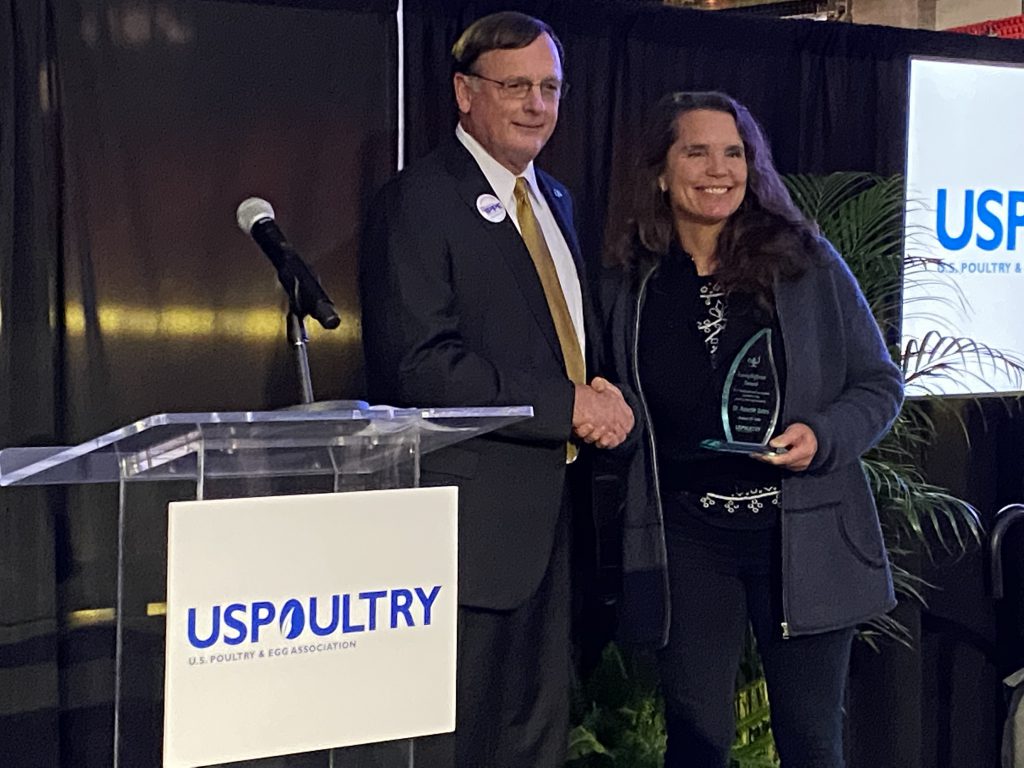
Posted in Uncategorized
Leave a comment
Almond orchards buzz with activity before pollination – from Ag Alert
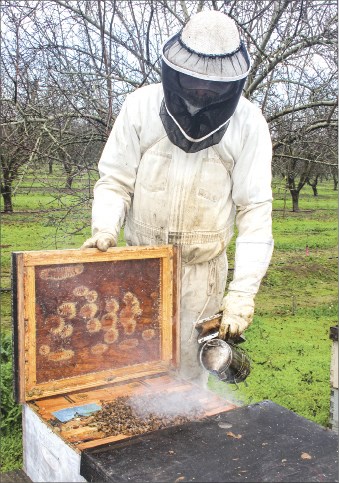
By Christine Souza
During the next few weeks, beekeepers will finish moving some 2.5 million honeybee colonies into California orchards to pollinate the state’s 1.2 million bearing acres of almond trees.
“We’re working really hard to supply a good supply of bees for the almond growers and doing everything that we can to keep up with their increase in production,” Butte County beekeeper Buzz Landon said.
As another 300,000 almond acres come into production in the next few years, beekeepers and farmers say an additional 600,000 beehives will be needed for pollination. Achieving that could be somewhat daunting, as beekeepers report annual bee losses due to challenges such as reduced forage, the Varroa mite and pesticide-related issues.
At the annual conference of the American Honey Producers Association and Canadian Honey Council, held recently in Sacramento, state Food and Agriculture Secretary Karen Ross said California border stations cleared 1.82 million beehives to enter the state in 2019.
Going into this season, Ross reminded beekeepers to register movement of beehives in and out of orchards to protect the apiaries from theft and from applications of crop protection materials. The state’s BeeCheck program requires beekeepers to register beehive locations with county agricultural commissioners. Last year, agricultural commissioners added BeeWhere, a software program to assist beekeepers in registering beehives.
Beekeeper Valeri Strachan-Severson of Yuba City said many out-of-state beekeepers oppose the registration program, but said, “It’s important. This has been on the books for 30 years.”
Daren Williams, senior director of communications for the Almond Board of California, said he expects almond production to grow from the current 2.3 billion pounds to the 3 billion-pound mark.
“For at least the next three to five years, most experts are projecting that this industry is going to continue to grow in acreage and in pounds. Of course, the pounds that we produce are very dependent upon pollination,” Williams said.
Last week, the Almond Board announced a new, five-point Pollinator Protection Plan aimed at protecting bees. The plan includes new collaboration with the nonprofit Pollinator Partnership; educating farmers and pollination stakeholders; improving communication; increasing on-farm floral diversity; and supporting bee health research.
At the honey producers conference, almond grower Ryan Cosyns of Madera, who used to manage honeybees, addressed pollination prices during a panel discussion.
“We need beekeepers that are pricing their product at a price that warrants what they had put into it,” Cosyns said. “The minimum price this year should be about $200 a hive. If you’re pricing under that, you’re doing yourself an injustice.”
In turn, beekeepers warned growers to watch out for “fly-by-night bee brokers,” who they said undercut the business with less than standard-quality bees.
Pollination services, Williams pointed out, represent “a significant input cost for growers, about 15 to 20% of a grower’s total production costs.”
Farmers have experimented with a self-fertile almond variety, Independence, which requires fewer bee colonies for pollination. Cosyns said the trees are only a fraction of the state’s total almond acres, and that planting of the variety has slowed because it does not have the same flavor as nonpareil, the top almond variety.
Many beekeepers at the conference had their minds on getting out and checking bees they had moved into bee yards or orchards.
Stanislaus County beekeeper Matt Beekman said he stored his apiaries in a bee yard in anticipation of bloom.
“For my growers, we’re doing some supplemental feeding in preparation for almond pollination, and we’re expecting to start moving bees either this week or the following week, depending upon the weather,” Beekman said.
A few miles away in Ballico, Merced County almond grower Eric Harcksen, who also brokers honeybees, said things are getting busy in the orchards.
“We have beekeepers from Indiana who are here in our almonds right now,” Harcksen said, adding, “We broker their bees; they bring them in from Indiana and then I put them into the almonds for them and take them out.”
During the honey conference, Iowa-based beekeeper Alex Ebert said he tripled the number of beehives he brought to California this year.
“After we get done with the conference, then we go take a look at how the bees are doing and get ready for almond pollination in February,” Ebert said.
Tulare County beekeeper Steve Godlin, who lost 100 beehives to theft last year at this time, said people in rural areas should be aware of the possibility of beehive thefts and suspicious activity.
“If you live near an almond orchard and see somebody loading bees onto a truck and out of the orchard, they are likely being stolen, so please call law enforcement,” Godlin said. “Get a license plate number or photo and report it.”
Hilmar Farm Watch, a rural-watch group working with law enforcement, reported 32 beehives allegedly stolen Jan. 7 from the Stevinson area of Merced County.
Posted in Uncategorized
Leave a comment
Aspiring farmers learn craft at Sonoma County teaching farm – from the San Francisco Chronicle
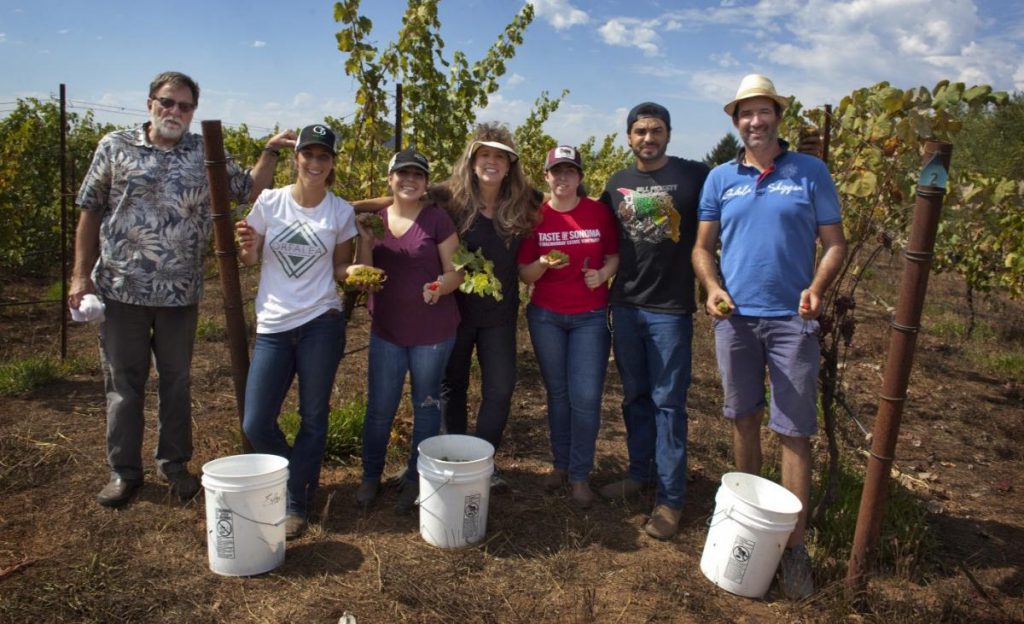
By Matt Villano
They’re growing more than grapes and produce at Shone Farm in Forestville — they’re growing farmers, too.
The 365-acre parcel is both a working farm and an outdoor learning laboratory, the place where students in Santa Rosa Junior College’s Agriculture and Natural Resources department get hands-on experience. The property is one of the largest college farms in the country, according to the American Association of Community Colleges. It also is one of the most diverse field-teaching labs in the country — a place where students study to become grape growers, winemakers, farmers, park rangers and pest-control specialists.
The farm opens to public visitors at least once a month for nine months of the year.
On these free-admission public days — dubbed Pick & Sip days — visitors are welcome to come, marvel at livestock, pick and buy in-season produce and grass-fed beef, taste wine and olive oil made from estate grapes and olives, and interact with students and professors alike.
The events themselves have a festival atmosphere: music playing, people talking and laughing, the products center stage as the stars of the show. Lynn Ellerbrock, sales and marketing coordinator, said in addition to fruits, veggies, wine and olive oil, the farm sells house-made value-added products such as strawberry preserves, Gravenstein apple syrup and dried heirloom beans.
“If we grow it or make it here, you can pick it up on one of our Pick & Sip days,” she said, noting that roughly 300 people attend each of the open-to-the-public events. “We feel this is a great way for outsiders to come, visit and get to know the farm.”
Ellerbrock added that free tastes of student-brewed craft beer also will be available on Pick & Sip days starting this summer after the farm resuscitates its brewery program in the spring semester.
There’s also a Fall Festival every harvest, which includes u-pick pumpkins and strawberries, hay rides, and more.
In addition to about 40 acres of buildings, the farm comprises 120 acres of forest, 100 acres of pasture, 90 acres of vineyard, 12 acres for crop production, and 4 acres of olive and apple trees. There also is open space around the farm’s perimeter that serves as wildlife corridors and habitat — this is home to a natural resources program that focuses on forestry, watershed restoration and wildlife habitat enhancement.
Taken as a whole, Shone Farm is one of the largest agriculture sites in the California Community Colleges system.
Students who complete coursework on-site are taught commercial production techniques that they can apply in the workplace or parlay into additional studies after transferring to a four-year university. The largest program, SRJC’s on-site Wine Studies Program, attracts 300 to 425 students each year.
During public days, though some of the action takes place in the fields adjacent to the parking lot, most of the event unfolds in the Warren G. Dutton Jr. Agricultural Pavilion, a sprawling building with an expansive patio that looks out on the Russian River Valley American Viticultural Area.
Go early enough in the day and from the patio you can look down on morning fog in the valley below.
“It really is a beautiful spot,” Ellerbrock says. “Beautiful and productive.
Posted in Uncategorized
Leave a comment
UC Davis opens bee research lab – from the Davis Enterprise
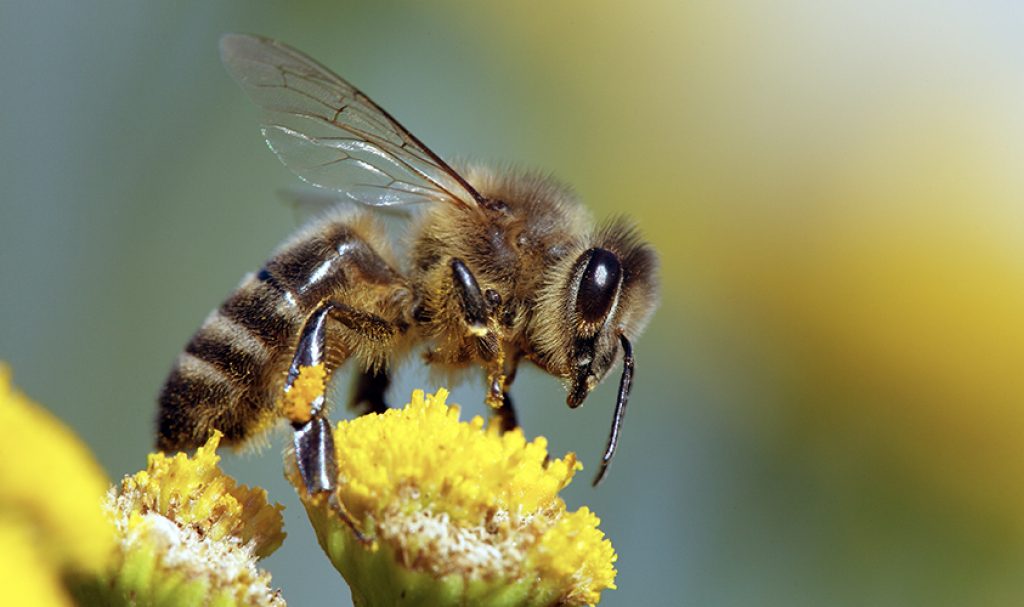
By Kathy Keatley Garvey
(EXCERPTED)
On a day too cold for honey bees to fly and nearly too cold for bundled dignitaries to speak, officials celebrated the opening of the newly constructed USDA-ARS bee research facility on Bee Biology Road on the UC Davis campus.
Queen bee breeder Jackie Park-Burris, a past president of the California State Beekeepers’ Association and a leader in the industry, snipped the ribbon in 45-degree temperature, joining a group of other stakeholders to open the facility.
“This is the only USDA bee research team in California — where the action is,” said emcee Paul Pratt, research leader of the Invasive Species and Pollinator Health Research Lab. USDA maintains honey bee research facilities in Tucson, Ariz.; Beltsville, Md.; Baton Rouge, La.; and Stoneville, Miss.
“The opening of the USDA-ARS bee lab marks a new opportunity for USDA and UC Davis entomologists to collaborate and investigate serious problems that affect stakeholders,” said Steve Nadler, professor and chair of the UC Davis Department of Entomology and Nematology. “We are very fortunate that the lab was built at UC Davis.”
Park-Burris, of Jackie Park-Burris Queens, Palo Cedro — her family has worked with UC Davis researchers for more than 80 years — cut the ribbon with four other stakeholders: almond pollination consultant Robert Curtis of Carmichael, former director and associate director (now retired) of Agricultural Affairs, Almond Board of California; Kevin Adee of Bruce, S.D., president of the American Honey Producers’ Association; Brad Pankratz of Can-Am Apiaries, Orland; and Darren Cox of Cox Honey Farms, Logan, Utah, a past president of the American Honey Producers’ Association.
Pratt introduced newly hired research entomologists, Arathi Seshadri and Julia Fine, forming the Invasive Species and Pollinator Health Research Unit at Davis. They are dedicated toward developing technology that improves colony survivorship through long-term studies of multiple stress factors, he said. “They will develop and transfer integrated biologically based approaches for the management of invasive species and the improvement of pollinator health.”
Seshadri and Fine aim to improve honey bee survival and beekeeping sustainability in California and nationwide, Pratt said. They will collaborate with federal, university, non-governmental and industry partners.
‘We are grateful’
In her talk, Park-Burris said that the “California State Beekeepers’ Association is overwhelmed that we have a USDA lab to collaborate with our UC Davis lab. We hope there’s a lot of collaboration going on. We really look forward to that. As a stakeholder, my family has been raising queens just north of here (Palo Cedro) for over 80 years. Dr. Laidlaw had worked with my uncle and my father. He’s been at my house. And he’s been through my bees. Julia (Fine) has even already been up to see the queen farm.”
“The queen bee breeding industry could definitely use you guys,” Park-Burris continued. “California has all the issues because everybody comes here. …it’s very important that we have this lab here and how grateful we are that you have all gone to the work to make this happen.”
“We look forward to solving some of our problems — varroa, varroa, varroa — and forage and pesticide interaction,” Park-Burris said, “and all that happens in California during the largest pollinator event in the world. So you’re in a good place and we’re grateful.”
UC Cooperative Extension apiculturist emeritus Eric Mussen later commented: “I think that the collaboration among the new USDA bee lab personnel, cooperating researchers, and beekeepers should provide an opportunity to probe deeply into potential causes of colony loss. The ability to follow the health of individual bees and colonies, throughout the year, should provide important clues about precursors of colony decline, well in advance of the ultimate collapse.”
Posted in Uncategorized
Leave a comment
Catch CDFA at Eco Farm conference in Pacific Grove
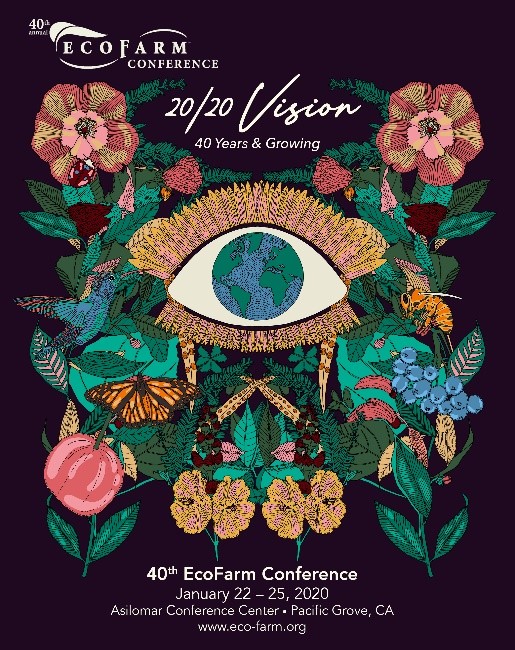
CDFA is pleased to be part of the 40th Eco Farm Conference starting today at Asilomar in Pacific Grove and running until Saturday, January 25.
On Friday, January 24, CDFA secretary Karen Ross will be joined by Central Coast congressional representative Jimmy Panetta for an informal question and answer session about key policy issues related to climate change, organics, marketing and other other key agricultural topics. The session will be moderated by EcoFarm’s Executive Director, Andy Fisher.
CDFA staff will participate in a series of workshops and also be available at information booths. Look for the Office of Environmental Farming and Innovation, the Inspection Services Division, the agency’s Farmer Equity and Tribal Affairs Advisor, CalCannabis, CDFA’s Produce Safety Program, and the State Organic Program.
Conference-goers will learn from leading experts on topics addressing both micro and macro issues critical to organic agriculture and the prosperity of small and mid-scale farmers. Several workshops will be presented in Spanish.
Posted in Uncategorized
Leave a comment
Remembering produce industry pioneer Frieda Caplan – from the Los Angeles Times
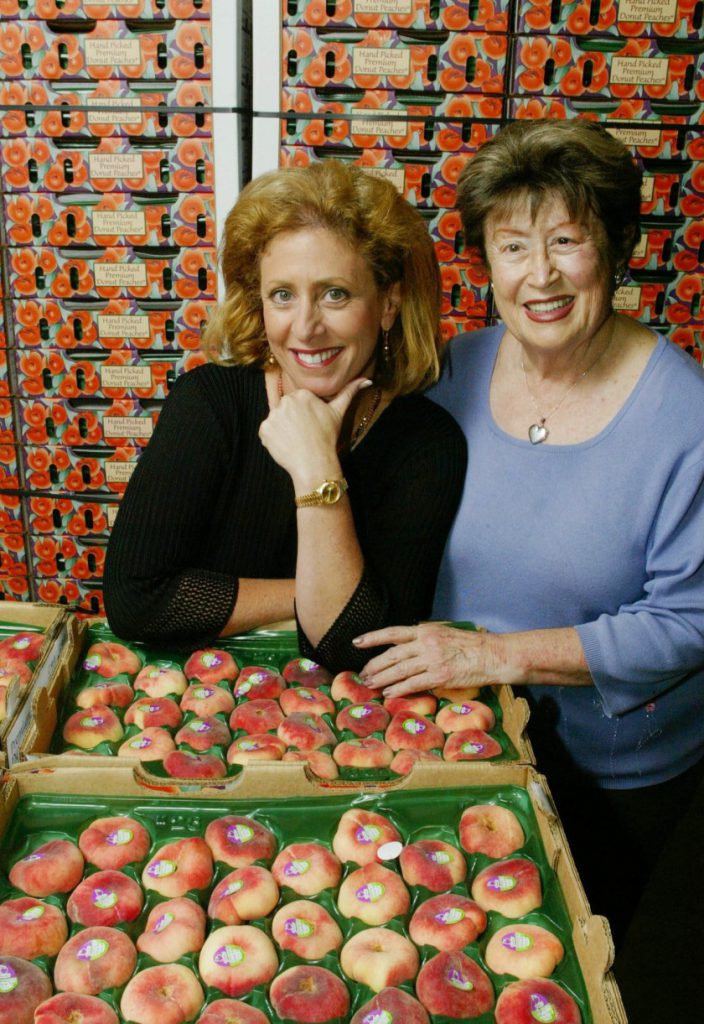
By Dorany Pineda and Gustavo Arellano
They called her “Kiwi Queen” and “Mother Gooseberry.” “Mushroom Lady” and “the “Mick Jagger of the produce world.” The woman who broke the glass ceiling in the testosterone-doused produce world and forever changed the way Americans eat fruits and vegetables.
She was Frieda Rapoport Caplan, a tenacious maven credited for introducing kiwis, mangoes, habanero and shishito peppers, passion fruit, bean and alfalfa sprouts, baby carrots, sugar snap peas, starfruit, blood oranges, shiitake mushrooms, turmeric, and hundreds more fruits and vegetables into the supermarket mainstream. Into the bellies of American consumers.
She was loquacious, driven and loved to take risks.
“I had a reputation of trying anything new,” she told the Pasadena Star-News in 2003. “I couldn’t compete with all the boys on the big items … so I built the business selling things that were different.”
That was the Caplan way, a gritty business owner deemed the first woman to own and run her own produce house in Los Angeles’ Wholesale Produce Market and the U.S.
In heels and a skirt, she revolutionized the way the produce world did business, adding recipes and cooking instructions on packages of “exotic” produce to tame the distrust of an unsuspecting public.
Caplan died Saturday morning in Los Alamitos after a brief illness, according to an email sent by her daughters, Karen Caplan — president and CEO of Frieda’s Specialty Produce — and Jackie Caplan Wiggins, the company’s chief operating officer. She was 96.
“Who the hell had heard of jicama or spaghetti squash?” said Ben Faber, a UC Cooperative Extension farm advisor who works with specialty crops. “We were a meat and potatoes society in the 1960s,” he added. “She changed our eating habits…. Frieda was able to tap into aspirations that people had after the Second World War … something new and different other than mac ‘n’ cheese.”
Born in 1923 in downtown L.A., Caplan was the daughter of Russian immigrants and raised in Highland Park. Like many great success stories, Caplan’s stratospheric rise as the mother and pioneer of specialty produce came from happenstance.
The year was 1945, and Caplan had recently graduated from UCLA with a degree in economics and political science. Soon after, she landed an office gig working for an attorney who headed the CIO’s political action committee in L.A.
In 1951, she married labor consultant and president of a longshoreman’s union, Alfred Hale Caplan. Four years later, they had their firstborn, Karen.
She started searching for a job with flexible hours, as she wanted to care for and breastfeed her baby at home. Her husband’s uncle and aunt, who managed a produce house, happened to be looking for a bookkeeper, so they brought Caplan on board.
Then her boss went on vacation, and Caplan was asked to fill in as a cashier. As buyers came in for produce, the young Caplan nudged them toward a pallet of fresh brown mushrooms. One man agreed, but his order was massive, and they didn’t have enough in stock to fill his request.
She panicked.
Everyone she called was out of the fungi, so she went hunting for them at the Ocean View Mushroom Farm in Orange County. They too were sold out, but she saw employees packing mushrooms and lent a hand.
She got what she wanted and filled the buyer’s request.
It was a steady trajectory from there as Caplan developed her marketing expertise.
Encouraged by the manager for the Southern Pacific Railroad, which ran the market, Caplan launched her own business with the help of a loan from her father, focusing on overlooked foodstuffs.
“The other people on the market were only interested in high-volume items,” Caplan once said. “Small farmers had no place to go. Nobody was interested. So I started listening to all these small farmers.”
And slowly, her reputation for selling fruits and vegetables no one had heard of stateside had swelled.
“Go to Frieda,” growers and buyers often heard when they sought an offbeat product no one knew about.
The kiwi, Caplan’s first claim to fame, made its debut after a Safeway buyer asked if she carried “Chinese gooseberries,” which he’d encountered on a recent trip to New Zealand.
She didn’t. But months later, a broker walked through the market with a box and Caplan bought some. She renamed the brown fuzzy edible kiwifruit, thinking customers would find its new name more appealing.
It took nearly a decade for the fruit to popularize. “I like to call it our 18-year overnight success,” she once said. Ironically, she grew allergic to the fruit in her later years.
“Her introduction of kiwi made people less risk-averse to try new things,” said Marianne McGarry Wolf, head of Cal Poly San Luis Obispo’s Agribusiness Department.
Gradually, Caplan carved out a niche for herself. After hustling for years, working from 1 a.m. to 5 p.m. daily, Caplan founded her own company in 1962. Purple became her signature color because, at the time of her business launch, it was the only hue the sign maker she hired had on hand.
“There have always been exotic food items,” Caplan told The Times in 1972 on the key to success. “We just showcased them, dressed them up and sold them.”
She even supplied the “alien” fruits for “Star Trek” episodes, which helped boost sales.
Also a sales success was her introduction of packaged produce, an idea that spawned when customers in Chicago couldn’t tell the difference between the ginger and sunchokes they’d purchased from her.
So Caplan found a solution: She labeled their products and added a note telling customers to call Frieda’s for recipes and more information. “We were flooded with letters,” Caplan said in the 2015 documentary “Fear No Fruit.” Every week, they received 400 to 800 letters.
“Success came because I never saw obstacles,” she told the Orange County Register in 2018.
In the mid-1980s, when Frieda’s Inc. had established itself as an industry leader, she told The Times that her success was due to the health and fitness craze of the time, medical reports stating that eating more fresh produce showed a lower cancer rate, and a spurt of restaurants specializing in fresh and exotic foods.
Before long she was supplying produce to stores like Vons, Ralphs, Trader Joe’s, Bristol Farms and Whole Foods.
The media had long ago taken notice of her, and had been following her rocketing career.
The Times in 1990 listed Caplan as one of a dozen Californians — including Steve Jobs and Jane Fonda — who shaped American businesses in the 1980s.
“You gotta hand it to her,” said an admirer to The Times in 1972. “She made something from nothing. There isn’t a produce man in the market who doesn’t take his hat off to her.”
And throughout her long, fruitful life and career, others took their hats off to her, too.
Her many accolades included an honorary degree of Doctor of Humane Letters from Cal Poly San Luis Obispo; a Lifetime Achievement Award from United Fresh Produce Assn.; a Legacy Award from National Assn. of Women Business Owners; received the first Working Woman’s magazine’s first Harriet Alger Award for Entrepreneurship; and was the first woman to receive The Packer newspaper’s “Produce Man of the Year” in the 1970s, which she rejected until it was renamed “The Produce Marketer of the Year.”
By 2018, Frieda’s, Inc. had boomed into a $50-million-plus business with 75 full-time and 110 part-time employees, an 81,000-square-foot warehouse in Los Alamitos and customers from across the world.
Until recently, Caplan still showed up to work. Cane in hand, always donning purple, she filed invoices and kept a keen eye on the next big product, leaving her daughters Karen and Jackie to run the business.
“She works like someone is keeping time on her,” her granddaughter and the company’s sales manager Alex Berkley once said.
But despite all her innovations and accomplishments, her accolades and title as “the marketing genius who galvanized the California farm industry and almost singlehandedly created fruit and vegetable trends,” as many described her, there’s one thing Caplan didn’t do: She never learned how to cook.
Posted in Uncategorized
Leave a comment
FDA statement lifting romaine lettuce consumer advisory
The U.S. Food and Drug Administration (FDA), along with the U.S. Centers for Disease Control and Prevention (CDC) and state and local partners, previously reported on December 12, 2019, that public health experts were tracking three separate outbreaks linked to romaine lettuce caused by three different strains of E. coli O157:H7. We also reported that, through the FDA’s traceback investigation, we were able to identify a common grower between each of these outbreaks in Salinas, California based on available supply chain information.
The FDA is providing an update on the status of the E. coli O157:H7 illnesses linked to romaine lettuce, along with recent findings based on our investigation of fields linked to a common grower, which was identified in our traceback. It should be noted that romaine from this grower does not explain all of the illnesses seen in these outbreaks.
Outbreaks declared over, consumer advisory lifted
The FDA is lifting the consumer advisory to avoid romaine lettuce from Salinas as the growing season for this region is over, and there is no longer a need for consumers to avoid it. There is also no need to avoid other produce products from Salinas.
The FDA and CDC have been tracking two multi-state romaine lettuce outbreaks. Federal health officials are declaring both multi-state romaine lettuce outbreaks over. One of the outbreaks sickened 167 people in 27 states. The other outbreak, linked to Fresh Express salad kits, sickened 10 people in five states.
There was also a third outbreak in Washington State that sickened 11 people. This outbreak has also been declared over.
The last reported illness onset date for all the outbreaks was December 21, 2019. Based on this information, it appears that our November 22, 2019 advisory to not eat romaine from Salinas played an important role in preventing illnesses and containing this outbreak because it prompted the removal of romaine lettuce from Salinas from the marketplace and warned consumers to throw away romaine from that growing region.
Common grower, multiple fields investigated
The FDA traceback investigation for these outbreaks required investigators to go through hundreds of supply chain records to find a commonality to a single grower with multiple fields. We were able to narrow this down further to at least 10 fields in the lower Salinas Valley.
Investigators from the FDA, CDC, the California Department of Food and Agriculture and the California Department of Public Health, visited several of these fields and took a variety of samples from water, soil and compost. So far, sample results have come back negative for all of the three outbreak strains of E. coli O157:H7. However, we did find a strain of E. coli that is unrelated to any illnesses in a soil sample taken near a run-off point in a buffer zone between a field where product was harvested and where cattle are known to occasionally graze. This could be an important clue that will be further examined as our investigation continues. However, this clue does not explain the illnesses seen in these outbreaks.
Our investigation is ongoing, and we are doing everything possible to find the source or sources of contamination. The investigation into how this contamination occurred is important, so romaine growers can implement measures that will prevent future contamination and illnesses.
The FDA is planning to conduct an additional, in-depth, root-cause investigation. The investigation will further characterize how contamination might have occurred and will inform what preventive controls are needed to prevent future outbreaks. Once complete, we plan to issue a prompt report and share lessons learned, so that growers can implement best practices to protect consumers from contaminated produce.
Investigation will inform future prevention
As we mentioned in our last update, it is important to remember that millions of servings of fresh leafy greens are safely eaten every day by consumers, although the repeat nature of these outbreaks linked to leafy greens – and more specifically to romaine lettuce – remains a concern.
We are doing our part by continuing our sampling assignment to monitor for pathogens in romaine lettuce across the nation. Industry can and must do their part too. Everyone across the romaine supply chain must do everything possible to fully understand why and how these outbreaks keep happening and continue to aggressively implement preventive measures to further protect consumers.
Outbreaks illustrate need to stay focused on prevention
It’s critical that all stakeholders, including growers, processors, distributors and retailers, stay laser-focused on prevention to help bend the curve of foodborne illness. We understand the importance of food safety, and we know there’s a human face to every foodborne illness.
The FDA remains committed to doing everything we can to prevent outbreaks, working with fellow regulators and the food industry to identify and address causes and keep consumers aware of potential risks.
Rest assured that we are working hard every day to try to prevent foodborne illness. We also know that food safety is a shared responsibility. It involves food producers, distributors, manufacturers, retailers and certainly regulatory officials at the federal, state, local, territorial and tribal levels. That’s why we work directly with our partners on things such as training and inspections. We also work closely with industry, so they understand our requirements and are educated on the latest scientific standards and good agricultural practices. Working together, we have and will continue to advance food safety.
A New Era of Smarter Food Safety
While we will always place emphasis on prevention, being able to promptly respond to an outbreak when it occurs is a critical part of our food safety mission.
As public health agencies have gotten better at detecting foodborne illnesses, our ability to trace back to the source of contaminated foods that may have caused the illnesses has lagged, due in part to the lack of modernized food traceability capabilities.
As part of the FDA’s New Era of Smarter Food Safety initiative, we plan to use advances in technology to improve our ability to track and trace products through the supply chain. We’ll be launching a New Era of Smarter Food Safety Blueprint in early 2020 that will outline how we will advance our work in this area. This blueprint will help consumers get information more quickly, enabling people to better protect themselves and their families.
We look forward to continuing our work with growers, processors, distributors and retailers in our shared efforts to protect consumers, and we will continue to provide updated information as it becomes available.
Posted in Uncategorized
Leave a comment
Fitbits for cows? From the Weatherford (TX) Democrat
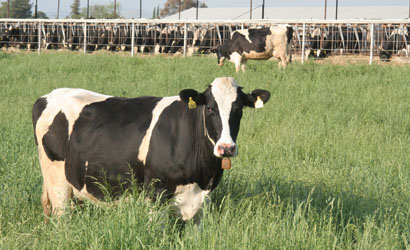
By Madelyn Edwards
Researchers at Tarleton State University’s Southwest Regional Dairy Center in Stephenville are using devices similar to Fitbits to track the health habits of dairy cows.
The researchers are saying that tracking a cow’s eating, sleeping and movement helps them take better care of the animals, according to a press release from the Texas A&M University System. The devices track how long cows eat, how long they lay down and how many steps they take, while another wearable device monitors how much milk each cow gives.
“We have two Fitbits on every cow,” Southwest Regional Dairy Center Director Barbara Jones said in the press release. “They help us to monitor their health, and to keep them content. And that matters to us because we truly do care about cows, as all producers do.”
The data can warn producers that a cow may be sick before the cow starts showing symptoms. The devices also free up time for the dairy producer, who can tend to other business instead of monitoring their herd visually, according to the press release.
Parker County Ag Extension Agent Jay Kingston said the wearable devices could have multiple benefits for dairy cows and farmers.
“Being able to track the health status of each and every cow with actual data and not just the ‘eye test’ will go a long way in identifying health issues earlier and provide more immediate care,” Kingston said. “This, in turn, will help lower costs for medical care and increase the production time for the cow. In my experiences, farmers and ranchers take animal health and care very seriously. This is another tool they can use to do that better.”
Former dairy farmer Tuck Densmore, who is also in charge of the dairy show division at the Parker County livestock show, said a dairy cow’s health can depend on its environment. Dairy cows are healthier when they can get more time to walk around and eat fresh grass.
“Some [dairies] have the environment where cows never leave the lot,” Densmore said. “They go in the milk barn and they go back to a lot and they stand in a lot all day. Some dairies have it to where their cows, when they’re not being milked, go out into a pasture and actually go eat grass.”
Dairy farmers usually determine a cow’s health by looking at it, Densmore said. To keep cows healthy, their environment needs to be clean, and quality feed needs be provided. Sickness in dairy cows can affect the milk if the cow has a fever.
About 10% of dairy farmers use wearable technology now, but as labor costs rise, more dairy producers are expected to take the technological leap, Jones said.
“The research we do here helps to make sure the cows stay content and happy,” Jones said. “That not only benefits the animal, it makes life easier for the producer, and allows them to make better decisions on the farm.”
Cost of the technology may stand in the way of farmers using it, Kingston said, but farmers may use it more once they see a return on their investment. So far, Kingston said he hasn’t heard of the devices being used in Parker County.
“Production and animal care practices have advanced so much over the years,” Kingston said. “I don’t see why dairy farmers won’t start using this technology if it can improve their management practices on the farm.”
Milk production can already be tracked, but there has never been a device to track the health of cows, Densmore said. He isn’t sure a device to track the movements of a cow would be useful.
“The whole point is milk production, and however many steps a cow takes a day, does that affect the amount of milk it makes? No,” Densmore said. “That is all affected by their breeding and the nutrition that they’re given each day. I guess it could have a small advantage. If you’re tracking it, you want them to be healthy and if they’re not getting enough steps a day, that’s probably not as healthy as the ones who are.”
Posted in Uncategorized
Leave a comment


